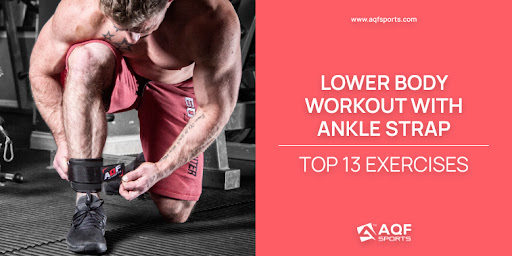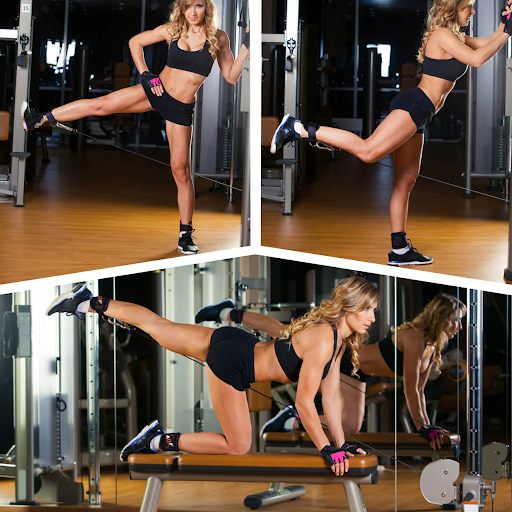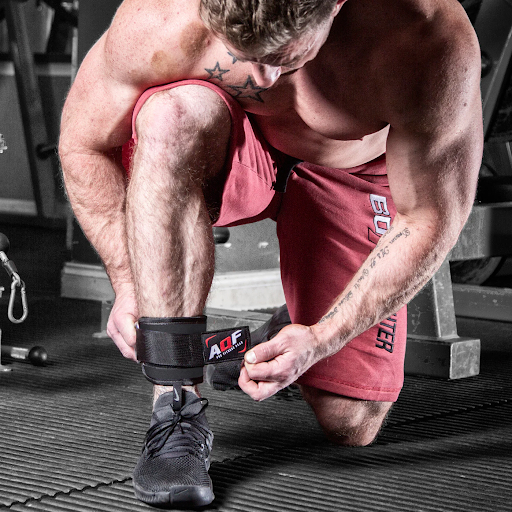Lower Body Workout with Ankle Strap [Top 13 Exercises]

Don’t skip leg day! Especially if achieving a thoroughly toned physique is your fitness goal. Muscle weakness, limited range of motion, instability, and workout plateaus are some of the many lower body fitness challenges. Lower body workout with ankle strap directly addresses common lower leg fitness concerns.
Scientific research supports that ankle Strap isolates certain muscle groups to correct imbalances and promote greater stability during dynamic movements. [1]
Furthermore, ankle strap workout improves flexibility and fuller range of motion – thus, reducing risk of muscle strains and joint discomfort.
Lower body workout with ankle strap is ideal if you want to:
- Overcome workout plateaus
- Gain lower leg strength
- Correct your imbalances
- Define your leg muscles
- Achieve a toned lower body physique

Lower Body Workout with Ankle Strap – Beginner Exercises
Standing Leg Raise:
Target Muscle Groups: Gluteus medias (side of the hip), gluteus minims, hip abductors (outer thighs).
How to Perform:
- Attach the ankle strap to your ankle and stand with feet shoulder-width apart.
- Hold onto a support for balance.
- Lift your strapped leg straight to the side.
- Lower your leg back to the starting position.
Expected Results: Improved hip stability, stronger outer thighs, and toned glutes.
Suggested Read: 15 Days Lower Body Challenge! 13+ Cable Leg Exercises For Stallone-Style Leg Muscles

Leg Curls:
Target Muscle Groups: Hamstrings (back of the thigh), gluteus maximus (buttocks).
How to Perform:
- Attach the ankle strap to your ankle, lying face down on a bench or mat.
- Hold onto the bench or mat for support.
- Bend your knee to bring your heel toward your glutes.
- Lower your leg back to the starting position.
Expected Results: Strengthened hamstrings, improved lower body balance, and a firmer butt.

Standing Hip Extension:
Target Muscle Groups: Gluteus maximus, hamstrings, lower back.
How to Perform:
- Attach the ankle strap to your ankle and stand with feet shoulder-width apart.
- Hold onto a support for balance.
- Lift your strapped leg straight behind you.
- Lower your leg back to the starting position.
Expected Results: Stronger glutes, more defined hamstrings, and improved lower back stability.

Standing Calf Raises:

Target Muscle Groups: Gastrocnemius (calf muscles), soleus.
How to Perform:
- Attach the ankle strap to your ankle and stand with feet hip-width apart.
- Hold onto a support for balance.
- Rise up onto your toes by pushing through your forefoot.
- Lower your heel back down below the level of your toes.
Expected Results: Stronger and more defined calf muscles, improved ankle stability.
Lower Body Workout with Ankle Strap – Intermediate Exercises
Bulgarian Split Squats:
Target Muscle Groups: Quadriceps (front of the thighs), gluteus maximus, hamstrings.
How to Perform:
- Attach the ankle strap to your ankle and stand a few feet away from a bench or step.
- Place one foot behind you on the bench.
- Bend your front knee to lower into a lunge position.
- Push through your front heel to return to the starting position.
Expected Results: Increased leg strength, enhanced muscle definition in quads and glutes, and improved lower body stability.
Standing Hip Adduction:
Target Muscle Groups: Inner thigh (adductors).
How to Perform:
- Attach the ankle strap to your ankle and stand with feet hip-width apart.
- Hold onto a support for balance.
- Lift your strapped leg straight across your body.
- Lower your leg back to the starting position.

Expected Results: Toned inner thighs, improved hip stability, and better balance.
Glute Kickbacks:
Target Muscle Groups: Gluteus maximus, hamstrings.
How to Perform:
- Attach the ankle strap to your ankle and get on your hands and knees.
- Lift your strapped leg straight behind you, keeping it in line with your body.
- Lower your leg back to the starting position.
Expected Results: Stronger and more defined glutes, improved hamstring strength, and enhanced lower body tone.

Seated Leg Extensions:
Target Muscle Groups: Quadriceps (front of the thighs).
How to Perform:
- Attach the ankle strap to your ankle and sit on a bench or chair.
- Extend your strapped leg straight in front of you.
- Bend your knee to lower your leg back down.
Expected Results: Increased quadriceps strength and definition, better knee stability.

Standing Hip Flexion:
Target Muscle Groups: Hip flexors.
How to Perform:
- Attach the ankle strap to your ankle and stand with feet hip-width apart.
- Hold onto a support for balance.
- Lift your strapped leg straight in front of you.
- Lower your leg back to the starting position.
Expected Results: Improved hip flexor strength, better hip mobility, and enhanced leg control.

Lower Body Workout with Ankle Strap – Pro Exercises
Step-Up with Knee Drive:
Target Muscle Groups: Quadriceps (front of the thighs), gluteus maximus, hip flexors.
How to Perform:
- Attach the ankle strap to your ankle and stand facing a sturdy bench or step.
- Step up onto the bench with your strapped leg.
- As you step up, drive your opposite knee upward toward your chest.
- Lower your knee back down and step down from the bench.
Expected Results: Increased quad and glute strength, improved hip mobility, and enhanced coordination.

Lateral Leg Raises:
Target Muscle Groups: Gluteus medius (side of the hip), gluteus minimus, hip abductors (outer thighs).
How to Perform:
- Attach the ankle strap to your ankle and stand with your feet together.
- Hold onto a support for balance.
- Lift your strapped leg straight out to the side.
- Lower your leg back down to meet the other.
Expected Results: Toned outer thighs, enhanced hip stability, and improved lateral leg strength.

Standing Reverse Leg Lifts:
Target Muscle Groups: Gluteus maximus, hamstrings, lower back.
How to Perform:
- Attach the ankle strap to your ankle and stand with feet shoulder-width apart.
- Hold onto a support for balance.
- Lift your strapped leg straight behind you.
- Lower your leg back to the starting position.
Expected Results: Stronger glutes, well-defined hamstrings, and improved lower back stability.

Standing Donkey Kicks:
Target Muscle Groups: Gluteus maximus, hamstrings.
How to Perform:
- Attach the ankle strap to your ankle and stand with feet hip-width apart.
- Hold onto a support for balance.
- Lift your strapped leg straight behind you while keeping your knee bent.
- Lower your leg back to the starting position.
Expected Results: Sculpted glutes, increased hamstring strength, and better overall lower body tone.

Which Muscles Does Ankle Strap Workout Isolate?
Ankle strap exercises can isolate and target several key lower body muscles effectively:
Gluteus Maximus:
This is the largest muscle in the buttocks and is responsible for hip extension. Exercises like hip thrusts and standing leg lifts effectively target the gluteus maximus.
Gluteus Medius:
Situated on the outer part of the hip, it assists with hip abduction and stabilization. Standing leg lifts and lateral leg raises are excellent for isolating the gluteus medius.
Gluteus Minimus:
Also located on the outer hip, it contributes to hip abduction and rotation. Standing hip abduction exercises with ankle straps focus on the gluteus minimus.

Hamstrings:
Found at the back of the thigh, these muscles are responsible for knee flexion and hip extension. Leg curls and Romanian deadlifts using ankle straps can effectively isolate the hamstrings.
Quadriceps:
Situated on the front of the thigh, these muscles handle knee extension. Leg extensions and Bulgarian split squats with ankle straps are ideal for targeting the quadriceps.

Hip Flexors:
These muscles facilitate hip flexion and play a crucial role in activities like walking and running. Standing hip flexion exercises with ankle straps engage the hip flexors effectively.
Hip Adductors:
Located on the inner thigh, these muscles are responsible for hip adduction. Standing hip adduction exercises with ankle straps can isolate the hip adductors.

Calf Muscles (Gastrocnemius and Soleus):
These muscles are responsible for ankle plantarflexion (pointing the toes downward). Standing calf raises with ankle straps are great for targeting the calf muscles.

Lower Body Workout With Ankle Strap – Weekly Plan
Day 1: Quadriceps and Hamstrings (Approx. 45-60 minutes)

Day 2: Rest or Active Recovery
- Consider activities like yoga, walking, or light stretching for recovery.
Day 3: Glutes and Hip Abductors (Approx. 45-60 minutes)

Day 4: Rest or Active Recovery
- Continue with rest or gentle activities to support recovery.
Day 5: Inner Thighs and Hip Flexors (Approx. 45-60 minutes)

Day 6: Rest or Active Recovery
- Continue with rest or low-impact activities to promote recovery.
Day 7: Calves and Lower Back (Approx. 45-60 minutes)

Total Duration
1. Increase lower body strength:
- Within a few weeks to 2-3 months (Beginner to Intermediate).
- Significant strength gains: 3-6 months (Intermediate).
- Advanced strength levels: Beyond 6 months to several years of consistent training (Advanced).
2. Define Leg Muscles:
- 2-4 months (Intermediate).
- Well-defined leg muscles: 4-6 months (Intermediate to Advanced).
- Strikingly defined legs: 6 months and beyond (Advanced).
3. Improve muscle endurance:
- A few weeks to 2-3 months (Beginner to Intermediate).
- Notable endurance gains: 3-6 months (Intermediate).
- Advanced endurance levels: Beyond 6 months to several years of consistent training (Advanced).
Expected Results
- Increased lower body strength.
- Enhanced muscle definition in legs.
- Improved muscle endurance.
- Better balance and stability.
- Enhanced flexibility.
- Improved athletic performance.
- Increased metabolism.
- Potential reduction in pain (e.g., back and knee).
Tips to Increase Effectiveness of Lower Body Workout with Ankle Strap
Isometrics Add Power:
Ever tried holding a squat halfway down? Isometric exercises, where you hold a static position against resistance, can intensify muscle engagement. For example, a paused squat can build strength and endurance in the lower body.
Pre-Exhaust for More Impact:
Start your workout with isolation exercises that target smaller muscle groups. For instance, try leg curls before squats. This technique exhausts smaller muscles, so larger ones work harder during compound movements.
Go Unilateral for Balance:
Don’t underestimate single-leg exercises. They can uncover and correct muscle imbalances while boosting stability. A Bulgarian split squat is a great example that engages various muscle groups effectively.
Pause Reps Challenge Muscles:
Want to intensify your workout? Incorporate pause reps. Take a moment to pause at the most challenging part of an exercise, like the bottom of a squat. It increases muscle tension and encourages growth.
Vary Your Range of Motion:
Switch things up by exploring different ranges of motion. Deep squats and partial squats, for instance, recruit muscle fibers differently, promoting balanced muscle development.
Eccentric Training Builds Muscle:
The lowering phase of an exercise, known as the eccentric phase, can be a goldmine for muscle growth. Lower weights or your body slowly and in control to maximize muscle engagement and promote hypertrophy.
Suggested Read: What Are The Best Foods To Eat For Muscle Growth?
Active Recovery Between Sets:
Keep your muscles engaged and nimble with active recovery techniques. Try dynamic stretches, a bit of yoga, or light mobility work between sets. It enhances efficiency and minimizes stiffness.
Get Creative with Resistance:
Spice up your workouts with resistance bands or chains. They provide variable resistance, challenging your muscles differently at various points in each exercise. It’s a great way to encourage muscle adaptation.
Suggested Read: 13 Mini Resistance Bands Exercises for Beginners
Explore Blood Flow Restriction (BFR) Training:
Under professional guidance, consider blood flow restriction (BFR) training. It involves using bands or cuffs to temporarily restrict blood flow to the muscles. Studies suggest it can lead to impressive muscle growth and strength gains, even with lighter weights.
How to Wear an Ankle Strap?

- Put the ankle strap around your ankle, just above the ankle bone.
- Ensure a snug fit that’s comfortable, not too tight.
- Use the provided closure (like Velcro or a buckle) to secure it firmly in place.
- Check for any twists or discomfort in the strap’s position.
- Make sure it’s securely fastened before starting your exercises.
Check the Ankle Strap Fitting
- A well-fitting ankle strap should feel comfortable and snug.
- You should not feel any pain, tightness, pinching, or blood flow constriction.
- It should stay in place and not slip or slide down your leg during movements.
- It should lie flat against your ankle – there should be twisting or bunching.
Ankle Strap Benefits for Lower Body Workout
Ankle straps can indeed be beneficial for lower body workouts, especially for targeting specific muscle groups and adding resistance. Here’s a concise breakdown:
Targeted Muscle Engagement:
Ankle straps engage targeted lower body muscles like the glutes, hamstrings, and outer thighs. Scientifically, a study published in the Journal of Strength and Conditioning Research indicated that ankle straps anchored horizontally with the body increased muscle activation in the gluteus maximus during exercises like hip extension compared to no ankle straps [source]
Enhanced Resistance:
Attaching ankle straps to resistance bands or cables provides external resistance, intensifying lower body exercises like leg curls, kickbacks, and hip abductions. This added resistance helps in muscle strengthening and toning. Research from the Journal of Human Kinetics found that using ankle weights (similar in function to ankle straps for resistance) led to significant improvements in lower limb muscle strength [source].
Stability and Form:
Ankle straps aid in maintaining proper form and stability during exercises, reducing the risk of injury and ensuring effective muscle engagement.
Who Should Wear Ankle Straps and When?
Ankle straps during strength training can be advantageous for specific exercises and certain individuals:
Exercises Requiring Leg Support:
When performing exercises like cable kickbacks, leg curls, or hip abductions, ankle straps can aid in targeting specific leg muscles effectively by providing stability and allowing for better isolation.
Individuals Aiming for Muscle Isolation:
For those focusing on isolating and working particular leg muscles, ankle straps assist in maintaining form and targeting the intended muscle groups without compensating with other body parts.
People Seeking Extra Resistance:
Ankle straps can also be used to attach resistance bands or cables, adding external resistance to leg exercises, thereby intensifying the workout.
However, ankle straps are not mandatory for all strength training exercises. They are primarily beneficial for specific movements that target the lower body and offer enhanced stability and isolation. As always, it’s essential to ensure proper form and consult with a fitness professional if needed to determine the suitability of ankle straps for your workout routine.
The Bottomline
Lower body workout with ankle strap promotes stability and muscle development in your lower back, glutes and legs. If you want to achieve a consistently toned physique, incorporate ankle strap lower body workout in your leg day and see amazing results.
Enjoy the workout!
Explore More Topics
- Rest Pause Training or Rest Pause Set: Benefits, Variations and Techniques
- Summer Body Workouts: Exercises for a Beach-Ready Physique
- Small Waist Workout (Complete Guide to Waist Trimming)
- How to Strap an Ankle – Step-by-Step Guide for Beginners
References:






